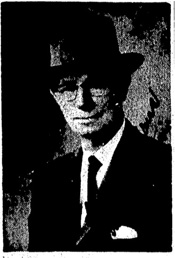Globe-Post, 29 July 1957
“To go a long journey to offer incense in a distant temple, is not so good as showing kindness near home.” ~Chinese Proverb, Swinton’s Fifth Reader.
There is a musical organization currently entertaining television audience whose spokesman tells us the band plays for fun. I can buy this. Furthermore, I am of the opinion the same could be said of nearly all musical organizations and individual performers as well. Many of these performers may be handsomely paid, but they also just love doing it.
-o.p.-
In my youth I played slide trombone. In this I was pretty much self-taught. And how I ever made it would be hard to explain. Earlier, I had been a miserable failure at both piano and violin even under competent instructors. But I had a certain love of music to be satisfied and it took a brass band to do it. And of all the brass instruments, the slide trombone appealed to me because of its tone and parts played. My interest was so great that I could listen to a band and wall off all but the trombone parts.
-o.p.-
As a trombone player my services were in demand here and there. And when they offered to pay me, I always accepted with a straight face. But really, I felt as though I were cheating. I enjoyed the work, call it work, so much.
-o.p.-
Because of little or not competition at the time, I became a member of an orchestra directed by Nick Koerting in LeMars. I was then playing a brass-finish instrument my father had ordered for me from Lyon & Lyon in Chicago. It had cost my dad ten dollars. Which was a heap of money just then.
-o.p.-.
Mr. Koerting and others of the orchestra were quite lavish in praise of my work. And it was suggested I might do even better with a new horn. And so, my dad dug even deeper for a horn costing nearly one hundred dollars. The new instrument was a Bessen, an English make handled exclusively by a Mr. Fischer in New York. And I was told my dad got it a little cheaper because Mr. Koerting just happened to be a local representative.
-o.p.-
The Koerting orchestra carried on for many years with varying personnel and instrumentation. From memory and my means of letters received I may list the names of many who were members of the group and my misses will be unintentional. However, it was Mr. Koerting who made the deal with Ralph Dalton for an orchestra to play Opera House attractions for money.
-o.p.-
The pay was small enough. As told to me, the job paid five dollars and would net those taking part fifty cents each. In addition, of course, we would see the show. And, as mentioned in the beginning since I nearly always played for fun anyway, I was really quite handsomely paid.
Let’s say the time was about 1905. Maybe a little earlier, but not much. Anyhow, an eight or ten piece orchestra playing show dates in a town the size of LeMars was something. We played the overture, between acts and the exit. Unknown to the audience, the actors often danced on the stage behind the curtain. And so, they also had fun.
-o.p.-
Now this group playing the Opera House dates was the orchestra I was supposed to tell about in the beginning. I got sidetracked when readers became interested in the Opera House story. And I guess, so did I.
-o.p.-
I’ll be back later with more about the old Opera House, but subject to corrections and additions, here is about the way I recall the personnel and instrumentation of the Opera House orchestra: Nick Koerting, director; Maude Steiner, piano; Fred Miller and George, clarinet; Hy Stapleford, cornet; Anton J. Sartori, trombone; Joe Wise, Kluckhohn, violin; Gus Koerting, string bass; and Louis Bellaire, traps.
-o.p.-

